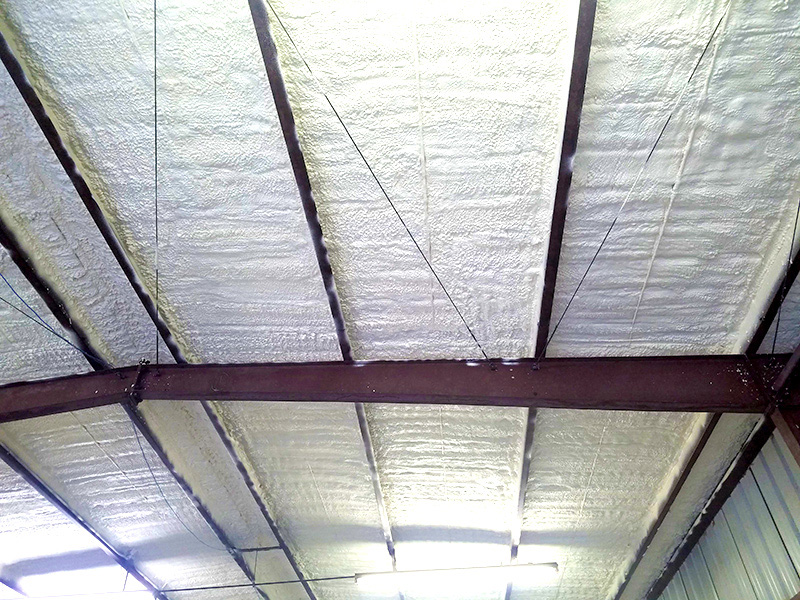
PRODUCTS & SERVICES
Products We Offer
Premium Foamsulate 210 CC
Premium Spray Products, Inc. Foamsulate 210 is a two-component, medium density, closed cell, one to one by volume spray applied polyurethane foam. To produce Foamsulate 210 requires the use of an “A” component (ISO) and a blended “B” component (RESIN) which contains ZERO Ozone Depleting blowing agents, catalysts, polyols and fire retarding materials.
Premium Foamsulate 50 OC
Foamsulate 50 is a two component, light density, one to one by volume spray applied polyurethane foam. To produce Foamsulate 50 requires the use of an “A” component (ISO) and a blended “B” component (RESIN), which contains ZERO ozone depleting blowing agents, catalysts, polyols and fire retarding materials. Foamsulate 50 is an insulation system designed for use in residential, commercial and industrial applications. Use in lieu of more traditional forms of insulating materials such as fiberglass, cellulose or other loose fill products.
Certainteed Certa- Spray OC and CC
CertaSpray® Closed Cell Foam is a two-component closed cell spray foam with a zero-ozone-depleting blowing agent. When CertaSpray A-side is mixed with CertaSpray B-side closed cell under pressure in a 1:1 volumetric ratio, they react and expand into a medium-density closed cell foam with an in-place core density of nominal 2.0 pcf.
Bayer Bayseal OC and CC
Bayseal OC open-cell spray-applied polyurethane foam insulation is produced with a two component, low density, non-structural insulation system designed for commercial, industrial and residential applications.
Services We Deliver
Open – Cell Spray Polyurethane Foam
Open-cell spray foam is a type of polyurethane foam that expands after application to fill gaps and irregular spaces. It’s made up of two components, a resin and a catalyst, that are mixed before being sprayed. The resin is usually polyurethane or polyethene, but the type used depends on the desired insulation.
Open-cell spray foam is named for the small, open cells that make up the foam. These cells are not completely encapsulated, making the foam softer and more flexible than closed-cell spray foam. The open-cell structure allows air to pass through, making it air permeable and absorbent. This makes open-cell spray foam ideal for insulation and roofing, as it can fill small spaces, promote ventilation, and help prevent mold and condensation.
Open-cell spray foam is often used for interior walls because it can reduce noise by blocking and absorbing air leakage. It’s also a cost-effective option for garage insulation, especially for storage. However, open-cell spray foam isn’t very effective as a vapor barrier in thin layers, so it may need an additional vapor barrier like plastic to prevent condensation.
Closed – Cell Spray Polyurethane Foam
Closed cell spray foam is a type of spray polyurethane foam that’s made up of tightly packed, uniform cells that trap air and maintain their shape. These cells are like tiny air pockets that are tightly pressed together, similar to inflated balloons. Closed cell foam is about four times denser than open cell foam and is more rigid, vapor semi-impermeable, and able to withstand greater pressure.
- Structural enhancement
- Vapor barrier
- Air barrier
- Versatility
- High performance
- Excellent insulation properties
- Strong and tear-resistant
- Mostly waterproof�
Basements, Crawl spaces, Exterior walls, Attics, Roofs, Metal buildings, Commercial properties, and Pole barns.�
**All of our Polyurethane Spray Foam Insulation products come with a Manufacturers warranty good for the life of the structure.
**All of our Polyurethane Spray Foam insulation applications come with a 10 year warranty on our labor.
What people who have worked with us have to say
EXCELLENTTrustindex verifies that the original source of the review is Google. The results I got surpassed my expectations. Within just a couple of days we noticed a marked difference in how my home was cooling and especially how much the A/C was running - and this was in July! I'm looking forward to seeing the effect this winter and have already seen an impact on my summer electric bills. My A/C system just seems to be more effective even though all I did was insulate my home better - something friends who have done this work told me about, but now I get it. Marc had excellent communication with me, and the installation team was super fast, efficient, skilled, knowledgeable, experienced and professional. All completed in one day. Marc's prices are reasonable and competitive, and he has a lot of experience that ensures the job will get done properly. He is conscientious and personable. Highly recommended.Trustindex verifies that the original source of the review is Google. GCS was the first insulation company where I spoke directly to the owner. Marc is very knowledgeable and his prices are competitive. The team got the job done in a day and we noticed the temperature difference immediately. Overall, it was great experience. Thank you!Trustindex verifies that the original source of the review is Google. Guys were very professional and I appreciate that they cleaned up after themselves thoroughly and done a high quality job at a very fair price .I can definitely feel good about recommending them thanks Marc and your crew for an excellent job.Trustindex verifies that the original source of the review is Google. Marc and his team were a pleasure to work with from the initial bid through installation. The team arrived early on a very hot morning and sprayed the attic thoroughly. Alex was lead and the team cleaned up and worked efficiently. I don’t know how they persevered in the heat. After the insulation dried, the temperature difference could be felt. We were very diligent in exploring various insulation options and companies. We are pleased with GCS and feel comfortable referring them to others. I am optimistic that our power bill will also reflect the installation with a decreased amount next month.Trustindex verifies that the original source of the review is Google. We had a great experience with this team. They were very professional, on time, and neat. We hired them to come last minute and clear the existing blown insulation above our living room/kitchen mid project and they did a great job of keeping the mess to a minimum and cleaning up behind themselves. We plan to hire their services for future projects and would absolutely recommend them to family and friends!Trustindex verifies that the original source of the review is Google. They did an excellent job at our new offices!Trustindex verifies that the original source of the review is Google. Excellent service start to finish - owner answered and visited for the quote. They were able to do our spray foam installation within a week of consult and finished within one day! We’re already seeing improvement in our air and retention of heat (it’s still winter). Plus, he told us about the tax credit!Trustindex verifies that the original source of the review is Google. Extremely pleased with the service and communication. They did more than they were supposed to. Price was more affordable than competitors. Don't waste your time getting bids. Just contact them only. You will be satisfiedTrustindex verifies that the original source of the review is Google. Marc responded quickly to my inquiry and provided a very reasonable quote. His team swiftly installed the spray foam and I am happy to report our 1899 building is comfy and running so much more efficiently! Highly recommend.Trustindex verifies that the original source of the review is Google. Great Company that worked through a difficult install. They will see you through and finish the job!

GCS Spray Foam
Marc S. Newman | Owner/Operator
Phone: 404.519.7012
Fax: 888.724.7561
2897 N Druid Hills Rd #261
Atlanta, GA 30329
Follow us on Facebook
Residential Service Areas:
Atlanta | Alpharreta |
* We cover the state of Georgia for all commercial spray foam services.
